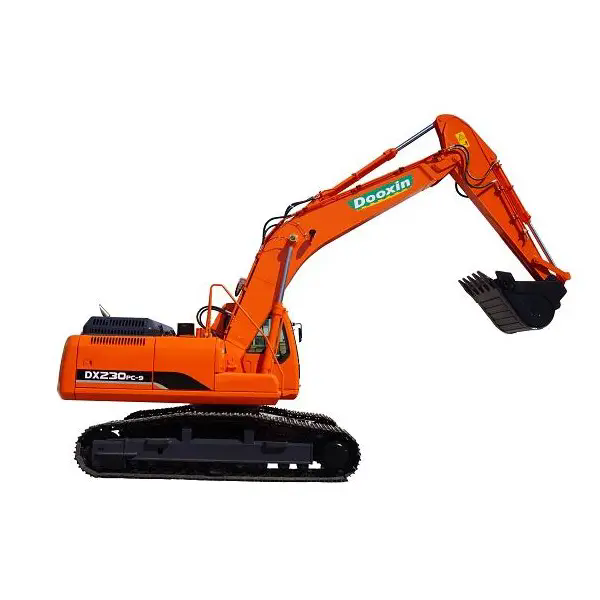Why Is the 23 Ton Crawler Excavator a Game-Changer for Mid-Scale Construction Projects?
2025-08-07
In the spectrum of construction machinery, the 23 ton crawler excavator occupies a unique sweet spot, balancing power, maneuverability, and efficiency to meet the demands of mid-scale projects. As urban development, road construction, and infrastructure upgrades continue to expand globally, this particular weight class has emerged as a versatile workhorse, capable of handling diverse tasks without the bulk of larger machines or the limitations of smaller models. For contractors and project managers seeking to optimize productivity while controlling costs, understanding why the 23 ton crawler excavator has become indispensable is key. This guide explores its critical role in modern construction, highlights its defining features, provides detailed specifications of our industry-leading model, and addresses common questions to aid in informed decision-making.
Trending News Headlines: Top Searches on 23 Ton Crawler Excavators
- "23 Ton Crawler Excavators: The Ideal Choice for Road Construction"
- "How 23 Ton Excavators Balance Power and Fuel Efficiency in Urban Projects"
- "2024’s Best 23 Ton Crawler Excavators for Utility and Demolition Work"
Why the 23 Ton Crawler Excavator Stands Out in Mid-Scale Operations
Perfect Balance of Power and Maneuverability
Mid-scale projects—such as road widening, commercial building foundations, and utility line installation—demand machinery that can handle heavy digging and lifting without being restricted by space constraints. The 23 ton crawler excavator strikes this balance: its robust engine and hydraulic system deliver enough power to dig deep trenches, load large trucks, and break concrete, while its compact footprint (compared to 30+ ton models) allows it to operate in urban areas, tight job sites, and residential neighborhoods. This versatility eliminates the need to switch between smaller and larger machines, streamlining operations and reducing downtime.
Cost-Effective Operations
For businesses managing mid-scale projects, cost efficiency is paramount. The 23 ton crawler excavator offers lower fuel consumption than larger excavators, making it more economical for daily use. Its maintenance requirements are also more manageable—parts are widely available, and servicing is less complex than for heavy-duty models—reducing long-term operational costs. Additionally, its ability to handle multiple tasks (with the right attachments) eliminates the need to invest in specialized machinery, further lowering equipment expenses. For contractors working on tight budgets, these savings translate to higher profit margins.
Adaptability to Diverse Terrains and Tasks
Mid-scale projects often involve varied terrains, from soft soil in residential lots to rocky ground in road construction. The 23 ton crawler excavator’s tracked undercarriage distributes weight evenly, providing stability on uneven or muddy surfaces and minimizing ground disturbance. This adaptability extends to task variety: with attachments like hydraulic hammers, grapples, and tilt buckets, it can transition seamlessly from digging to demolition, material handling, or grading. For example, a single machine can excavate a building foundation in the morning and clear debris in the afternoon, enhancing productivity and reducing the need for multiple equipment deliveries.
Compliance with Urban Regulations
Urban construction projects face strict regulations regarding noise, emissions, and machine size. The 23 ton crawler excavator is engineered to meet these standards: modern models feature low-emission engines (compliant with Tier 4 Final and EU Stage V regulations) that reduce environmental impact, while advanced soundproofing technology minimizes noise pollution—critical for work in residential areas or near schools and hospitals. Its size also avoids the need for special transport permits required for larger machinery, simplifying logistics and ensuring compliance with local traffic laws.
Operator Efficiency and Safety
Mid-scale projects often require long operating hours, making operator comfort and safety essential for productivity. 23 ton crawler excavators are designed with ergonomic cabs that reduce fatigue: adjustable seats, intuitive controls, and climate control systems keep operators comfortable during extended shifts. Safety features—such as reinforced ROPS/FOPS cabs, 360° cameras, and proximity sensors—protect operators from hazards like falling debris or collisions with other equipment. These features not only enhance job site safety but also reduce the risk of accidents, which can cause costly delays in project timelines.
Key Features of a Superior 23 Ton Crawler Excavator
When evaluating 23 ton crawler excavators, certain features distinguish high-performance models from average ones. These characteristics ensure reliability, efficiency, and long-term value:
Engine Performance
A powerful yet fuel-efficient engine is the backbone of a 23 ton crawler excavator. Top models are equipped with 6-cylinder diesel engines (typically 150-180 hp) from reputable manufacturers like Cummins, Volvo, or Isuzu, delivering consistent torque for heavy digging and lifting. Advanced fuel injection systems and turbocharging optimize combustion, reducing fuel consumption without sacrificing power. Emission control technologies—such as selective catalytic reduction (SCR) and diesel particulate filters (DPF)—ensure compliance with global environmental standards, making the machine suitable for use in regulated areas.
Hydraulic System
The hydraulic system determines the excavator’s digging force, speed, and precision. Superior 23 ton models feature load-sensing hydraulic pumps that adjust flow and pressure based on demand, minimizing energy waste and improving responsiveness. This results in faster cycle times (the time to complete a dig-lift-dump sequence) and smoother operation, allowing operators to work more efficiently. The hydraulic system should also include robust hoses, filters, and valves to withstand high pressure and prevent leaks, reducing maintenance needs.
Undercarriage Design
The undercarriage is critical for terrain adaptability and durability. A high-quality 23 ton crawler excavator features wide steel tracks (typically 600-700 mm) with reinforced links and aggressive treads for maximum traction. Sealed track rollers and idlers prevent dirt and moisture from entering, extending component life and reducing wear. The undercarriage should also include a robust frame and track tensioning system to withstand heavy loads and rough terrain, ensuring stability during digging and lifting operations.
Cab and Operator Features
The operator cab is designed to enhance productivity and safety. Key features include a spacious interior with adjustable seating, intuitive joystick controls, and a multi-functional display that monitors fuel levels, engine temperature, and maintenance alerts. Noise reduction technology (such as soundproofing and vibration damping) keeps cabin noise below 75 dB, reducing operator fatigue. Safety features include a reinforced ROPS/FOPS cab (certified to withstand rollovers and falling objects), 360° cameras with blind-spot monitoring, and emergency stop buttons. Some models also offer GPS integration for fleet tracking and job site mapping.
Attachment Compatibility
- General-purpose buckets (1.0-1.5 m³ capacity) for digging and loading
- Hydraulic breakers for concrete and rock demolition
- Grapples for handling debris, logs, or pipes
- Tilt buckets for precise grading and slope work
- Augers for drilling holes for poles or foundations
Our Premium 23 Ton Crawler Excavator Specifications
|
Feature
|
Specification
|
|
Operating Weight
|
23,000 kg
|
|
Engine
|
Cummins QSB6.7 (162 kW / 217 hp)
|
|
Maximum Digging Depth
|
7.2 m
|
|
Maximum Reach (Horizontal)
|
10.5 m
|
|
Maximum Loading Height
|
7.8 m
|
|
Bucket Capacity
|
1.0 - 1.5 m³
|
|
Track Width
|
600 mm (optional 700 mm for soft terrain)
|
|
Track Length
|
4,200 mm
|
|
Ground Pressure
|
45 kPa (with 600 mm tracks)
|
|
Fuel Tank Capacity
|
350 L
|
|
Hydraulic System Pressure
|
31.4 MPa
|
|
Hydraulic Flow
|
280 L/min
|
|
Cycle Time (Dig-Lift-Dump)
|
7.5 seconds
|
|
Cab Features
|
ROPS/FOPS certified; air-conditioned; heated seat; 10-inch touchscreen display with 360° camera; GPS tracking
|
|
Emission Standard
|
Tier 4 Final / EU Stage V
|
|
Noise Level (Cabin)
|
≤72 dB
|
|
Optional Attachments
|
Hydraulic breaker, grapple, tilt bucket, auger, compactor plate
|
|
Warranty
|
2 years / 5,000 hours
|



